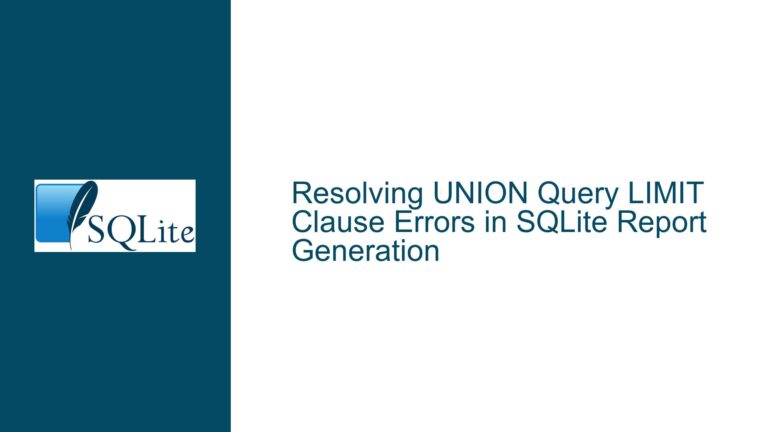SQLite C Interface Issue: Missing Tables in Query Results
Issue Overview: Missing Tables in Query Results When Using SQLite C Interface
The core issue revolves around a discrepancy in the results returned by a SQLite query executed via the C interface. Specifically, the application is designed to create and populate tables in a SQLite database upon startup. The code snippet provided demonstrates the process of querying the sqlite_master table to retrieve the names of all tables and views in the database. Subsequently, it attempts to insert data into a specific table named sys.abcattbl. However, the query only returns the tables created by the application itself, omitting other tables that are expected to be present in the database.
This behavior is problematic because it suggests that the application is either not accessing the correct database or is encountering an issue with the SQLite C interface that prevents it from retrieving the complete list of tables. The issue is further complicated by the fact that the application is running on Windows 8.1 with MSVC 2017, which may introduce platform-specific nuances that could affect the behavior of the SQLite C interface.
Possible Causes: Directory Mismatch, Database Connection Issues, and Query Execution Errors
One of the primary potential causes of this issue is a directory mismatch. As suggested by Stephan Beal, the application might not be running in the directory it expects, leading it to access a different database than intended. This could occur if the application’s working directory is not set correctly or if there are multiple databases with similar names in different directories. In such cases, the application might be querying a database that does not contain the expected tables, resulting in incomplete query results.
Another possible cause is an issue with the database connection. The SQLite C interface relies on a valid and active database connection to execute queries. If the connection is not established correctly, or if there is a problem with the connection handle (m_db in the code), the application might not be able to access the full set of tables in the database. This could be due to an incorrect database path, insufficient permissions, or a problem with the SQLite library itself.
Additionally, errors in query execution could also lead to incomplete results. The code snippet provided includes several steps where errors can occur, such as during the preparation of SQL statements (sqlite3_prepare_v2), binding parameters (sqlite3_bind_text), and executing statements (sqlite3_step). If any of these steps fail, the application might not retrieve the full list of tables, or it might skip certain tables due to errors in the query execution process.
Troubleshooting Steps, Solutions & Fixes: Verifying Database Path, Checking Connection Status, and Debugging Query Execution
To address the issue of missing tables in the query results, the following troubleshooting steps and solutions can be implemented:
1. Verifying the Database Path and Working Directory:
The first step in troubleshooting this issue is to verify that the application is accessing the correct database. This can be done by explicitly checking the database path and ensuring that the application is running in the correct working directory. One way to do this is to print the database path to the console or log file before establishing the connection. This will help confirm that the application is attempting to access the intended database.
If the database path is correct, the next step is to ensure that the application is running in the correct working directory. This can be done by using platform-specific functions to retrieve and print the current working directory. If the working directory is incorrect, it can be adjusted using the appropriate system calls or by specifying the full path to the database when establishing the connection.
2. Checking the Database Connection Status:
Once the database path and working directory have been verified, the next step is to check the status of the database connection. This can be done by examining the return value of the sqlite3_open or sqlite3_open_v2 function, which is used to establish the connection. If the connection fails, the return value will indicate an error, and the application should handle this error appropriately.
In addition to checking the return value, it is also important to ensure that the connection handle (m_db) is valid and active before executing any queries. This can be done by using the sqlite3_db_handle function to retrieve the connection handle associated with a prepared statement and verifying that it matches the expected handle.
3. Debugging Query Execution:
If the database path and connection status are both correct, the next step is to debug the query execution process. This involves examining each step of the query execution, from preparing the statement to binding parameters and executing the query. The following steps can be taken to debug query execution:
Preparing the Statement: The
sqlite3_prepare_v2function is used to prepare the SQL statement for execution. If this function fails, it will return an error code, which should be checked and handled appropriately. The error message can be retrieved using thesqlite3_errmsgfunction and printed to the console or log file for further analysis.Binding Parameters: The
sqlite3_bind_textfunction is used to bind parameters to the prepared statement. If this function fails, it will also return an error code, which should be checked and handled. The error message can be retrieved and printed in the same way as for thesqlite3_prepare_v2function.Executing the Statement: The
sqlite3_stepfunction is used to execute the prepared statement. If this function fails, it will return an error code, which should be checked and handled. The error message can be retrieved and printed for further analysis. Additionally, the return value ofsqlite3_stepshould be checked to ensure that the query executed successfully and returned the expected results.Resetting the Statement: After executing the statement, the
sqlite3_resetfunction is used to reset the statement so that it can be executed again. If this function fails, it will return an error code, which should be checked and handled. The error message can be retrieved and printed for further analysis.
By carefully examining each step of the query execution process, it is possible to identify and resolve any issues that may be causing the application to retrieve incomplete results. This may involve correcting errors in the SQL statement, ensuring that parameters are bound correctly, or handling errors that occur during query execution.
4. Handling Platform-Specific Nuances:
Given that the application is running on Windows 8.1 with MSVC 2017, it is important to consider any platform-specific nuances that may affect the behavior of the SQLite C interface. For example, Windows uses a different file system than Unix-based systems, which may affect how file paths are handled. Additionally, the MSVC 2017 compiler may introduce specific quirks or limitations that could affect the behavior of the SQLite library.
To address these potential issues, it is recommended to test the application on different platforms and compilers to ensure that the behavior is consistent. If platform-specific issues are identified, they can be addressed by modifying the code to handle these nuances appropriately. For example, the application could use platform-specific functions to handle file paths or adjust the code to account for any quirks introduced by the MSVC 2017 compiler.
5. Implementing Error Handling and Logging:
Finally, it is important to implement robust error handling and logging in the application to ensure that any issues that arise can be quickly identified and resolved. This involves checking the return values of all SQLite functions and handling any errors that occur. Additionally, the application should log detailed information about the database connection, query execution, and any errors that occur. This information can be used to diagnose and resolve issues more effectively.
By following these troubleshooting steps and implementing the suggested solutions, it is possible to resolve the issue of missing tables in the query results and ensure that the application functions as expected. This will involve verifying the database path and working directory, checking the database connection status, debugging query execution, handling platform-specific nuances, and implementing robust error handling and logging.






